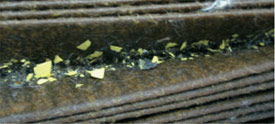

Dirty fuel is the main cause of engine fuel filter contamination. Although itís a difficult problem to isolate, airlines can take steps to deal with it, including auditing fuel suppliers to ensure that they are following applicable fuel handling requirements and replacing engine fuel filters more often.
AIRLINES MUST WORK WITH THEIR FUEL SUPPLIERS TO ENSURE THAT LOCAL FUEL HANDLING PROCEDURES ARE BEING FOLLOWED.
By Michael Jones
Senior Service Engineer, Propulsion
Fuel contamination can take many forms, but the result is often the same: a fuel filter bypass indication that may cause delays if the pilot elects to return to ground or divert to have the fuel filter inspected or replaced. This article addresses contamination of the engine fuel filter.
BACKGROUND
In 2003, the International Air Transport Association (IATA) Technical Fuel Group formed a team comprising airlines, airframe manufacturers, and fuel suppliers to study the reasons behind an increase in the number of reported fuel filter impending bypass indications and more frequent filter replacements being reported by airlines. The team examined many reports of contaminated fuel filters but could not determine a single cause of the problem. The majority of the fuel filters examined were filled with silicates (i.e., dirt), sulfates, iron oxide (i.e., rust), and salts (see fig.1). The team could not draw a specific conclusion but suspected that the contamination was being uplifted with the fuel. The team also suspected that the fuel technically would pass the ATA 103 fuel handling specification for cleanliness.
CONTAMINATION TRAPPED
BY A FUEL FILTER
Figure 1
A visual inspection of a fuel filter reveals a variety of contaminants.

[+] Enlarge
An impending bypass indication will show when the differential pressure switch in the engine fuel filter is actuated (10.5 to 12.5 pounds per square inch on the CFM53-3 engine). On the Boeing 737, the FILTER light on the P5-2 panel and MASTER CAUTION indicator will illuminate when this differential pressure switch is actuated. The Boeing 757, 767, 777, and 747-400 will show an engine fuel filter message on the Engine Indicating and Crew Alerting System.
FUEL FILTER BYPASS INDICATION
Fuel filter bypass indications are required by the Federal Aviation Administration (FAA). In its publication Airplane Turbofan Engine Operation and Malfunctions ó Basic Familiarization for Flight Crews, the FAA explains, ďIf the fuel filter at the engine fuel inlet becomes clogged, an impending bypass indication will alert the crew for a short while before the filter actually goes into bypass.Ē
The filter and indication system are designed so that the mission can be completed under normal levels of particulate contamination in the fuel. Most impending bypass indications occur during the takeoff roll or climb because this is the phase of flight that typically has the highest fuel flow through the filter, and greatest delta pressure across the filter.
If a flight crew receives a fuel filter bypass indication during a flight, procedures do not specifically call for a diversion or return to airport. It is up to the flight crew to return to ground, divert, or continue with the flight. If there are adequate alternate airports along the route of flight, and only a single engine fuel FILTER BYPASS light is illuminated, with no abnormal operation, the captain may make the decision to proceed with the flight. A fuel FILTER BYPASS light with any abnormal engine operation should be cause for a diversion. In addition, an immediate diversion should be performed if both engine bypass lights are illuminated or have illuminated during the flight.
In any case, itís important to keep in mind that the alert is an impending bypass indication: the filter can still handle several more grams of material before the bypass valve opens and it is unlikely an actual filter bypass would occur during that flight. At this point, if contamination gets past the filter, it is possible for the engine to shut down. However, Boeing has not had any reports of an engine shutdown due to dirt contamination.

